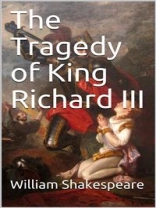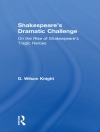Richard III is a historical play by William Shakespeare believed to have been written around 1593. It depicts the Machiavellian rise to power and subsequent short reign of King Richard III of England. The play is grouped among the histories in the First Folio and is most often classified as such. Occasionally, however, as in the quarto edition, it is termed a tragedy. Richard III concludes Shakespeare's first tetralogy (also containing Henry VI parts 1–3).
It is the second longest play in the Shakespearean canon after Hamlet and is the longest of the First Folio, whose version of Hamlet is shorter than its Quarto counterpart. The play is often abridged; for example, certain peripheral characters are removed entirely. In such instances, extra lines are often invented or added from elsewhere in the sequence to establish the nature of characters' relationships. A further reason for abridgment is that Shakespeare assumed that his audiences would be familiar with his Henry VI plays and frequently made indirect references to events in them, such as Richard's murder of Henry VI or the defeat of Henry's wife, Margaret.
The play begins with Richard (called "Gloucester" in the text) standing in "a street", describing the re-accession to the throne of his brother, King Edward IV of England, eldest son of the late Richard, Duke of York, implying the year is 1471.
Richard is an ugly hunchback who is "rudely stamp'd", "deformed, unfinish'd", and cannot "strut before a wanton ambling nymph." He responds to the anguish of his condition with an outcast's credo: "I am determined to prove a villain / And hate the idle pleasures of these days." Richard plots to have his brother Clarence, who stands before him in the line of succession, conducted to the Tower of London over a prophecy he bribed a soothsayer to finagle the suspicious King with; that "G of Edward's heirs the murderer shall be", which the king interprets as referring to George of Clarence (without realising it actually refers to Gloucester).
Richard now schemes to woo "the Lady Anne" – Anne Neville, widow of the Lancastrian Edward of Westminster, Prince of Wales. He confides to the audience:
I'll marry Warwick's youngest daughter.
What, though I kill'd her husband and her father?
The scene then changes to reveal Lady Anne accompanying the corpse of the late king Henry VI, along with Trestle and Berkeley, on its way from St Paul's cathedral to interment. She asks them to set down the "honourable load – if honour may be shrouded in a hearse", and then laments the fate of the house of Lancaster. Richard suddenly appears and demands that the "unmanner'd dog" carrying the hearse set it down, at which point a brief verbal wrangling takes place.
Despite initially hating him, Anne is won over by his pleas of love and repentance, agreeing to marry him. When she leaves, Richard exults in having won her over despite all he has done to her, and tells the audience that he will discard her once she has served her purpose.
The atmosphere at court is poisonous: The established nobles are at odds with the upwardly mobile relatives of Queen Elizabeth, a hostility fueled by Richard's machinations. Queen Margaret, Henry VI's widow, returns in defiance of her banishment and warns the squabbling nobles about Richard. Queen Margaret curses Richard and the rest who were present. The nobles, all Yorkists, reflexively unite against this last Lancastrian, and the warning falls on deaf ears.
Read this complete famous novel for further story….
William Shakespeare
The Tragedy of King Richard III [PDF ebook]
The Tragedy of King Richard III [PDF ebook]
Kup ten ebook, a 1 kolejny otrzymasz GRATIS!
Język Angielski ● Format PDF ● ISBN 9788834105498 ● Rozmiar pliku 0.5 MB ● Wydawca iOnlineShopping.com ● Opublikowany 2019 ● Do pobrania 24 miesięcy ● Waluta EUR ● ID 6995014 ● Ochrona przed kopiowaniem bez












